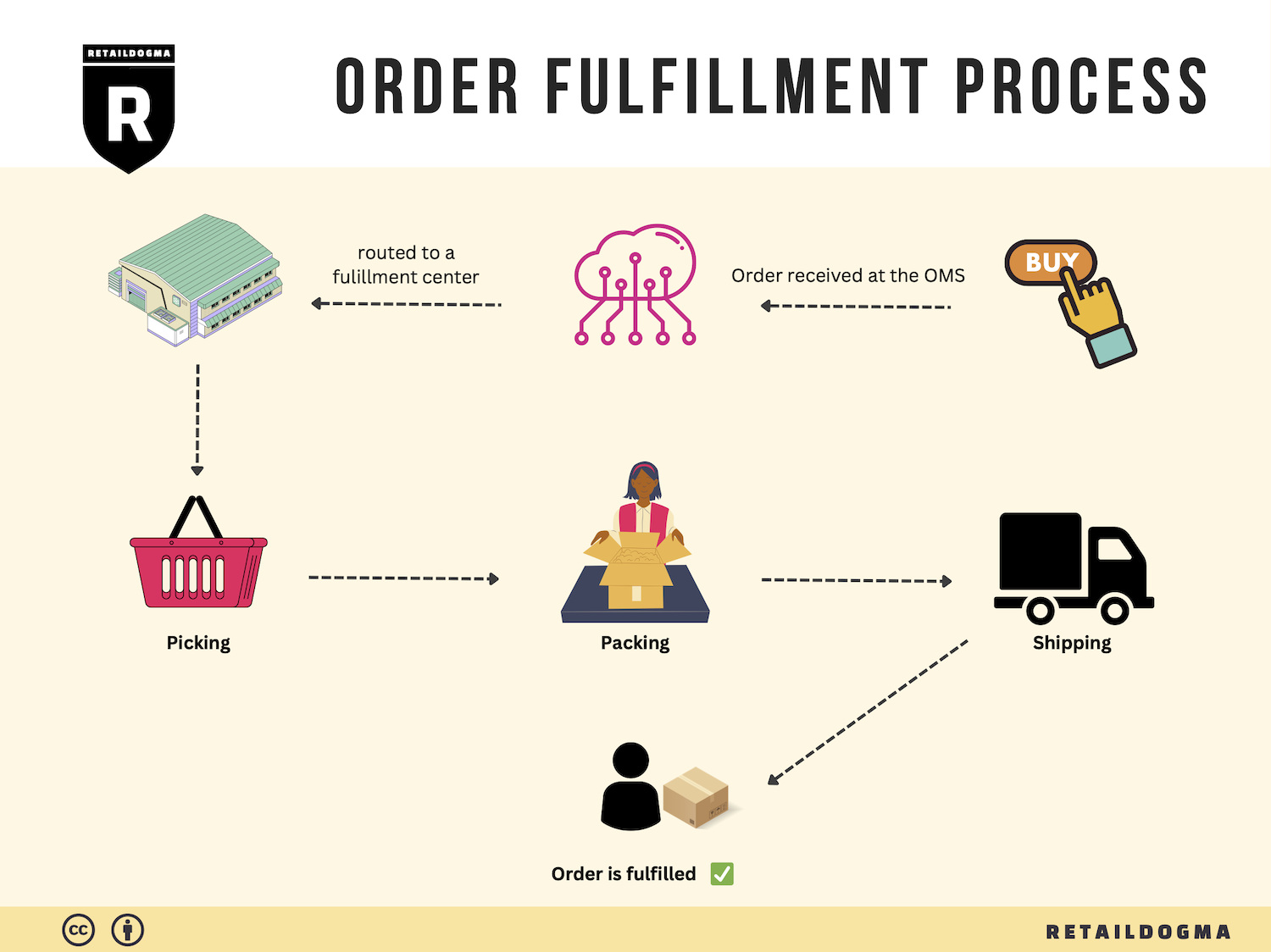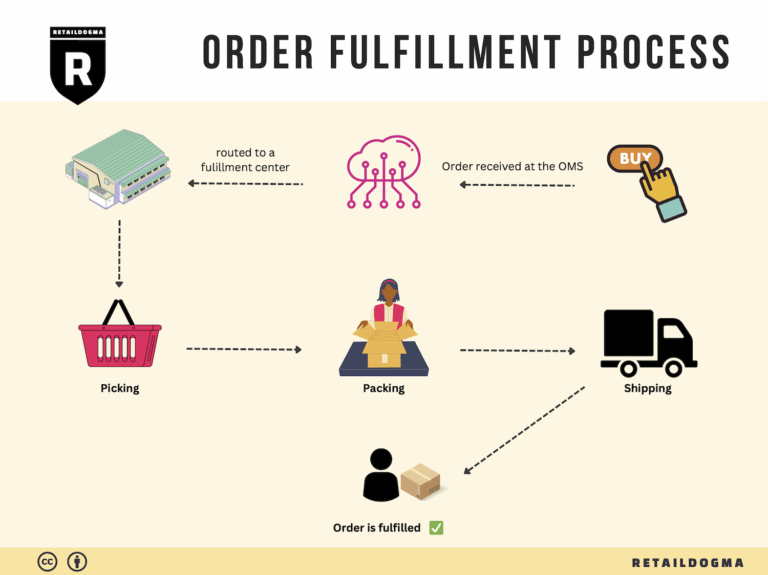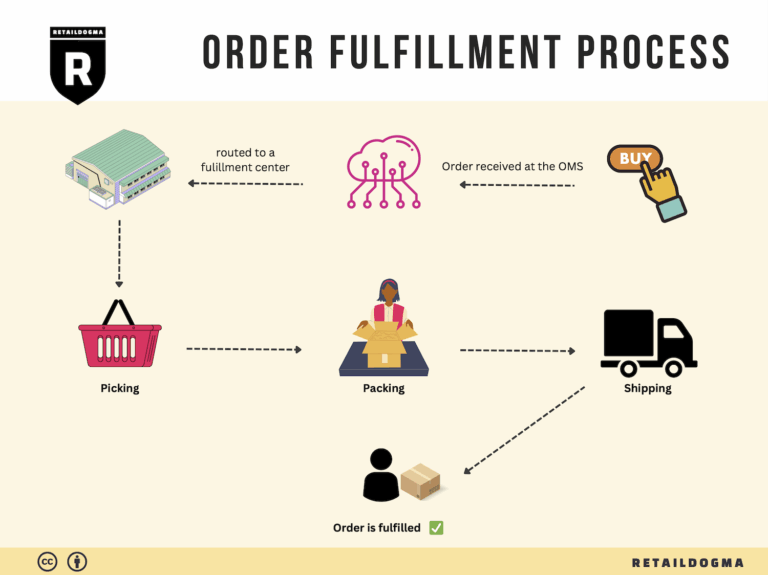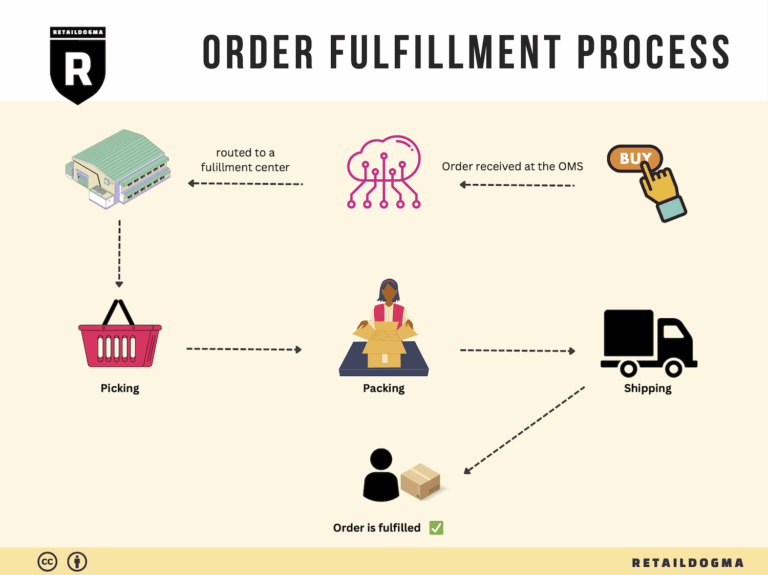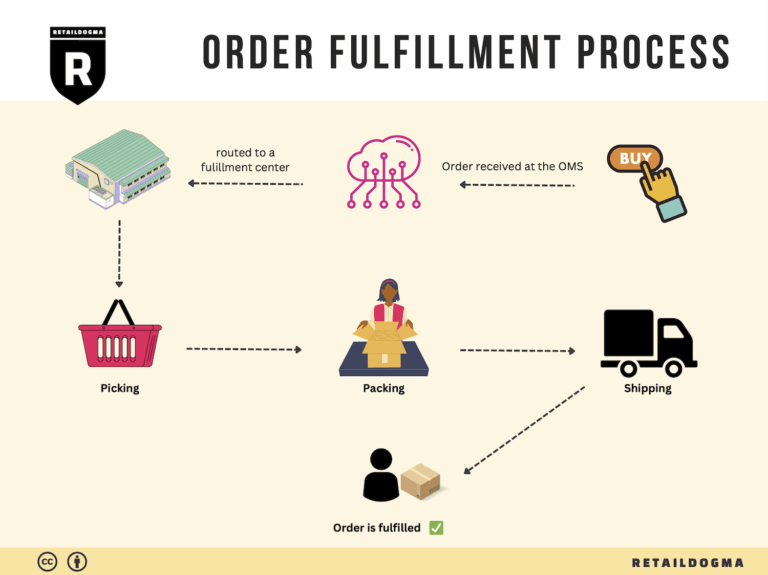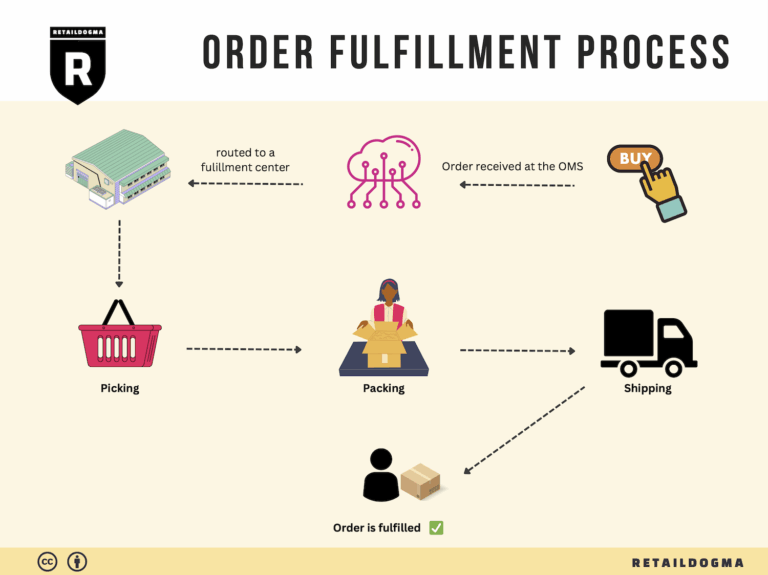How Order Fulfillment Works: A Step-by-Step Guide for Businesses
What is E-commerce Fulfillment? An Introduction for Growing Businesses
Understanding the Challenges of E-commerce Fulfillment
For many growing online businesses, the excitement of increasing sales can quickly turn into an overwhelming task of managing packing and shipping orders. As your customer base expands, so does the complexity of fulfilling orders efficiently. It’s not uncommon for entrepreneurs to find themselves buried in boxes, packing tape, and shipping labels, all while trying to maintain a high level of customer satisfaction. This is where understanding e-commerce fulfillment becomes crucial.
What is E-commerce Fulfillment?
At its core, e-commerce fulfillment is the process of getting a product into the hands of a customer. This encompasses everything from receiving inventory and storing products to picking, packing, and shipping orders. The fulfillment process can significantly impact your business’s efficiency, customer satisfaction, and ultimately, your bottom line.
What This Guide Covers
This comprehensive guide will explore several key areas of e-commerce fulfillment that can help you scale your operations effectively:
-
Fulfillment Models: We’ll break down various fulfillment models, including Third-Party Logistics (3PL) and Fulfillment by Amazon (FBA). Understanding these options will help you determine which model aligns best with your business needs.
-
Core Services: We’ll outline the essential services involved in fulfillment, such as inventory management, order processing, shipping, and returns handling. Each of these components plays a vital role in ensuring a seamless customer experience.
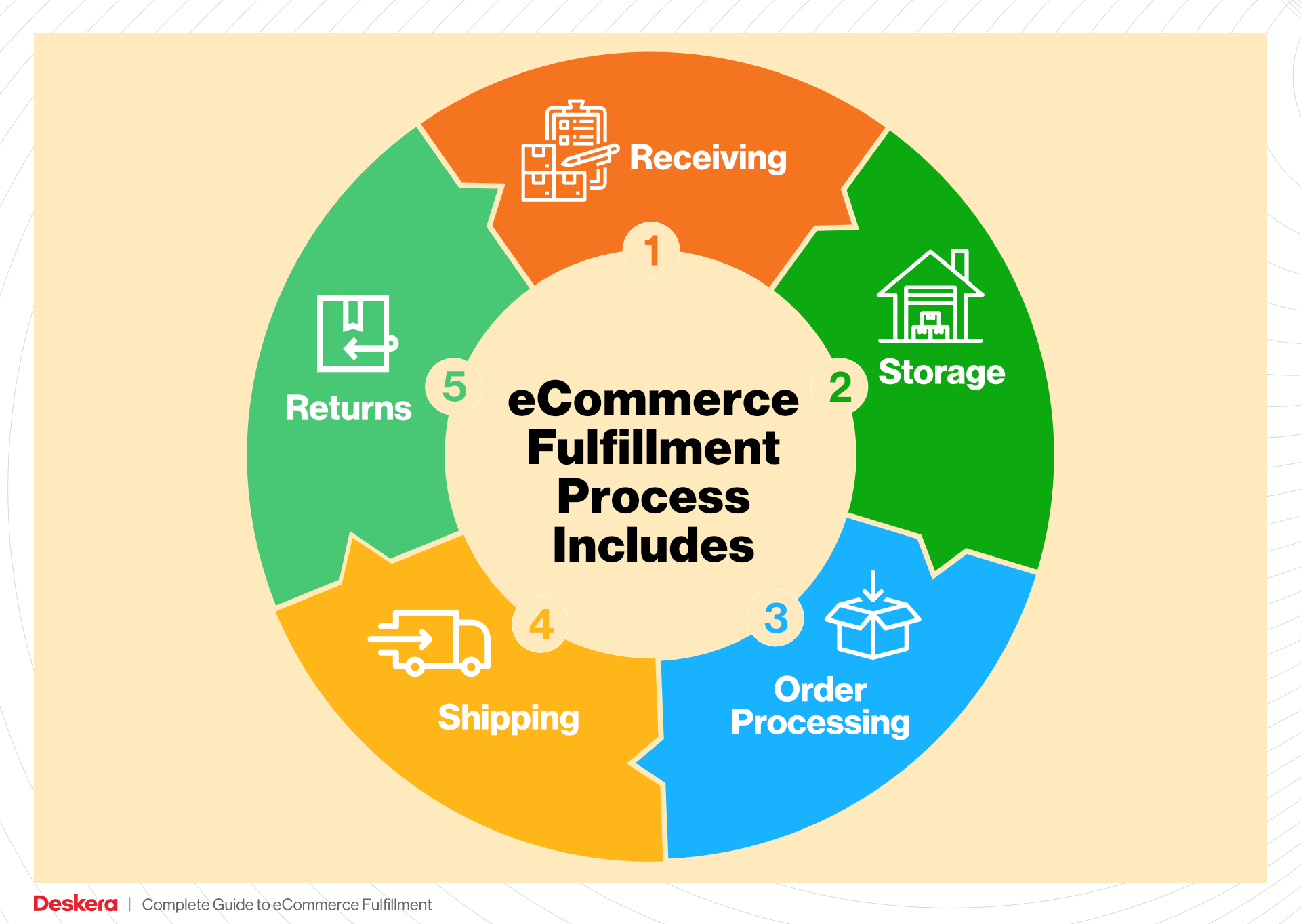
-
Choosing the Right Partner: Selecting the right fulfillment partner is critical for success. We’ll provide practical tips on what to look for in a fulfillment service provider, including technology integration, scalability, and customer support.
-
Pricing Structures: Understanding how fulfillment pricing works is essential for budgeting and cost management. We’ll discuss common pricing models and factors that can influence your fulfillment costs.
Empowering Your Business Decisions
The goal of this guide is to empower e-commerce business owners, operations managers, and entrepreneurs to make informed decisions about their logistics. By understanding the ins and outs of fulfillment, you can streamline your operations, enhance customer satisfaction, and ultimately support your business growth. As you read through this guide, you’ll gain the knowledge necessary to tackle your fulfillment challenges head-on, allowing you to focus more on scaling your sales and less on the logistical hurdles.
What You’ll Learn In This Guide
- What is E-commerce Fulfillment? An Introduction for Growing Businesses
- The Order Fulfillment Process: From ‘Buy’ Button to Customer’s Door
- Comparing Fulfillment Models: In-House vs. 3PL vs. Dropshipping
- A Deep Dive into Amazon FBA: Pros, Cons, and Who It’s For
- Core Services Offered by Fulfillment Centers
- How to Choose a Fulfillment Partner: A 6-Point Checklist
- Understanding Fulfillment Pricing: A Breakdown of Common Fees
- Frequently Asked Questions (FAQs) about Fulfillment
- Conclusion: Is Outsourcing Fulfillment the Right Move for Your Business?
- Important Disclaimer
The Order Fulfillment Process: From ‘Buy’ Button to Customer’s Door
1. Receiving Inventory
The order fulfillment process begins with receiving inventory, a crucial step that ensures your e-commerce business has the products available to meet customer demand. This phase involves the physical receipt of goods from suppliers, which may include your popular Good Times Fulfillment Fruit Blox – Apple & Strawberry Gummy Snacks. Upon arrival, the products are inspected for quality and accuracy against purchase orders.
Importance: Proper receiving minimizes discrepancies and ensures that the right products are available for sale. Any issues identified at this stage—such as damaged goods or incorrect quantities—can be addressed before they affect customer orders.
Key Term: SKU (Stock Keeping Unit) – A unique identifier for each product that aids in tracking inventory levels and sales performance.
2. Warehouse Storage
Once inventory is received and verified, the next step is warehouse storage. This involves placing products in designated storage areas within the warehouse or fulfillment center. Efficient storage solutions are vital for maintaining organization and ensuring quick access to items. For example, Fruit Blox snacks can be stored in an easily accessible section of the warehouse, labeled clearly to facilitate fast retrieval.
Importance: Effective warehouse storage reduces the time it takes to fulfill orders and helps maintain inventory accuracy. A well-organized warehouse can significantly improve operational efficiency and reduce the likelihood of stockouts.
Key Term: FIFO (First In, First Out) – An inventory management principle that ensures older stock is sold before newer stock, which is particularly important for perishable goods or items with a limited shelf life.
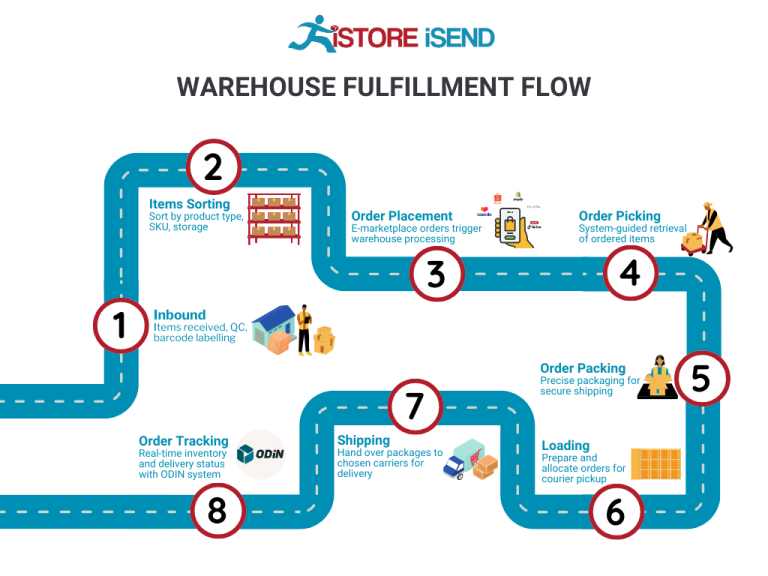
3. Order Picking
Order picking is the process of selecting items from the warehouse to fulfill customer orders. When a customer places an order for Fruit Blox, a pick list is generated, detailing the items and quantities needed. Warehouse staff use this list to locate and gather the products, ensuring that the correct items are picked and prepared for packing.
Importance: Accurate order picking is critical to customer satisfaction. Errors at this stage can lead to wrong items being sent, resulting in returns, refunds, and dissatisfied customers. Streamlining the picking process can help improve fulfillment speed and accuracy.
Key Term: Pick List – A document that outlines the items to be picked for each order, often including product SKUs, locations, and quantities.
4. Order Packing
Once the items are picked, they are moved to the packing station. During this step, products are carefully packed into boxes or envelopes, often using protective materials to prevent damage during transit. For example, when packing the Fruit Blox snacks, staff may choose boxes that fit snugly to minimize movement and potential damage.
Importance: Proper packing not only protects the items but also enhances the unboxing experience for customers. A well-packed order can lead to positive reviews and repeat business. Additionally, efficient packing processes can reduce shipping costs and improve overall order fulfillment speed.
Key Term: Packaging Materials – Materials used to protect and secure products during shipment, including boxes, bubble wrap, and packing peanuts.

5. Shipping & Delivery
The final step in the order fulfillment process is shipping and delivery. Once orders are packed, they are labeled and handed over to shipping carriers for delivery to customers. Businesses often provide tracking information to customers, allowing them to monitor their shipment’s progress. For example, Good Times Fulfillment may utilize various carriers to ensure timely delivery of their Fruit Blox snacks to customers nationwide.
Importance: Efficient shipping and delivery are crucial for maintaining customer satisfaction. Timely delivery can significantly impact a customer’s perception of your brand and their likelihood of making repeat purchases. Moreover, having a clear shipping policy can reduce customer inquiries and enhance trust.
Key Term: Last Mile Delivery – The final step of the delivery process, where the package is delivered from a transportation hub to the customer’s doorstep. This stage is often the most critical and can influence overall delivery satisfaction.
By understanding and optimizing each step of the order fulfillment process, e-commerce businesses can enhance operational efficiency, improve customer satisfaction, and ultimately scale their sales effectively. Each step plays a vital role in ensuring that products, like the popular Fruit Blox snacks, reach customers promptly and in excellent condition.
Comparing Fulfillment Models: In-House vs. 3PL vs. Dropshipping
Comparison of Fulfillment Models
| Model | Who Handles Inventory | Best For (Business Stage) | Key Advantage | Key Disadvantage |
|---|---|---|---|---|
| In-House Fulfillment | Business itself | Startups to Medium Enterprises | Full control over inventory and processes | Higher operational costs and complexity |
| Third-Party Logistics (3PL) | Third-party provider | Growing to Established Businesses | Scalable, cost-effective, and expert services | Less control over inventory and operations |
| Dropshipping | Supplier | Startups and Small Businesses | Low upfront costs and inventory risk | Lower margins and potential quality issues |
In-House Fulfillment
In-house fulfillment is a model where the e-commerce business manages its own inventory and order processing. This approach typically involves renting warehouse space, hiring staff, and acquiring the necessary technology to handle logistics. For startups and medium enterprises, in-house fulfillment offers significant advantages, such as complete control over the supply chain, which can lead to better quality assurance and faster response times to customer inquiries or issues. Businesses can customize their packaging and branding, providing a unique customer experience that can enhance brand loyalty.
However, the disadvantages are notable. In-house fulfillment requires substantial investment in infrastructure and workforce, which can strain cash flow, particularly for newer businesses. Additionally, as order volume increases, the complexity of logistics can escalate, leading to potential inefficiencies if not managed properly. Businesses must also stay updated on warehousing regulations and inventory management best practices, which can divert focus from core business activities.
Third-Party Logistics (3PL)
Third-party logistics (3PL) involves outsourcing fulfillment operations to a specialized logistics provider. This model is ideal for growing businesses that need to scale their operations without the burden of managing logistics in-house. 3PL providers offer a range of services, including warehousing, inventory management, order processing, and shipping, often employing advanced technology for tracking and efficiency.
The key advantage of using a 3PL is scalability. As your business grows, a 3PL can adjust to increased order volumes without the need for significant investments in additional infrastructure. This model also allows businesses to leverage the expertise of logistics professionals, who can optimize operations and potentially reduce shipping costs through established carrier relationships.
On the downside, businesses may face challenges related to control and communication. Relying on a third party means less oversight of the inventory and fulfillment processes, which can lead to discrepancies or delays if not managed properly. It is crucial to establish clear communication channels and performance metrics to ensure the 3PL meets your service standards. Additionally, while 3PLs can reduce operational burdens, they typically charge fees that can eat into profit margins, particularly for lower-volume businesses.
Dropshipping
Dropshipping is a fulfillment model where a business sells products without holding any inventory. Instead, when an order is placed, the retailer purchases the item from a third-party supplier, who then ships it directly to the customer. This model is particularly appealing for startups and small businesses due to its low upfront costs and reduced financial risk, as there is no need to invest in inventory upfront.
The primary advantage of dropshipping is its minimal capital requirement. Entrepreneurs can start an e-commerce store with a limited budget, focusing on marketing and customer acquisition rather than logistics. This model also allows for a wide range of products to be offered without the need for warehousing, making it easy to pivot or expand product lines.
However, dropshipping also comes with significant drawbacks. Margins can be thinner compared to other models, as suppliers typically charge wholesale prices that leave little room for profit. Additionally, quality control can be an issue, as the retailer has no direct oversight of the product before it reaches the customer. This can lead to customer dissatisfaction if the product does not meet expectations. Furthermore, shipping times can be longer, especially if the supplier is located overseas, potentially impacting customer satisfaction and retention.
Conclusion
Choosing the right fulfillment model is crucial for the success of your e-commerce business. Each model has its strengths and weaknesses, and the best choice will depend on your specific business stage, budget, and operational capabilities. Startups may find dropshipping or 3PL services more manageable, while established businesses with the resources to invest may benefit from the control of in-house fulfillment. Ultimately, aligning your fulfillment strategy with your business goals is key to achieving scalable growth and maintaining customer satisfaction.
A Deep Dive into Amazon FBA: Pros, Cons, and Who It’s For
Understanding Fulfillment by Amazon (FBA)
Fulfillment by Amazon (FBA) is a service that allows e-commerce sellers to store their products in Amazon’s fulfillment centers. Amazon takes care of storage, packaging, and shipping of products directly to customers, along with handling returns and customer service inquiries. This model is particularly appealing for sellers looking to scale their operations without the complexities of managing logistics themselves.
How FBA Works
-
Setup: Sellers create an Amazon Seller account and enroll in FBA. They then list their products on the Amazon marketplace.
-
Shipping Inventory: Sellers send their inventory to Amazon’s fulfillment centers. Amazon provides guidelines on how to prepare and package products for shipment.
-
Storage: Once the inventory arrives at the fulfillment center, it is stored until an order is placed. Amazon manages the storage, ensuring products are stored efficiently.
-
Order Fulfillment: When a customer places an order for a product, Amazon picks, packs, and ships the item directly to the customer. This process is typically rapid, often leading to same-day or next-day delivery.
-
Customer Service: Amazon handles customer service for FBA products, including returns, which alleviates a significant burden for sellers.
-
Fees: Sellers are charged fees for storage and fulfillment, which vary based on product size and weight.
Pros of Using FBA
1. Prime Eligibility
Products fulfilled through FBA are automatically eligible for Amazon Prime, which is a significant draw for many customers. Prime members often prefer Prime-eligible items due to the benefits of free shipping and faster delivery times. This can lead to higher sales and increased visibility in search results on Amazon.
2. Customer Trust
Amazon is a trusted platform, and using FBA enhances that trust. Customers are more likely to purchase from sellers who utilize FBA because they associate it with reliable shipping and customer service. This trust can translate into higher conversion rates for sellers.
3. Multi-Channel Fulfillment
FBA allows sellers to fulfill orders from multiple channels, not just Amazon. This means that if a seller has their own website or sells on other platforms, they can use Amazon’s logistics capabilities to handle those orders as well. This flexibility can streamline operations and reduce overhead.
4. Scalability
FBA enables businesses to scale without the typical growing pains associated with logistics. Sellers can increase their inventory and reach more customers without having to invest heavily in warehousing and fulfillment infrastructure.
5. Simplified Logistics
By outsourcing logistics to Amazon, sellers can focus on other essential aspects of their business, such as marketing and product development. This simplification is particularly beneficial for small to medium-sized businesses that may lack the resources to manage logistics effectively.
Cons of Using FBA
1. High Fees
While FBA offers many benefits, it does come at a cost. The fees for storage and fulfillment can add up, especially for sellers with lower-priced items or those who do not have high sales volumes. Sellers must carefully analyze their pricing strategy to ensure that FBA remains profitable.
2. Strict Inventory Rules
Amazon has strict guidelines regarding inventory management, including limitations on the number of units that can be stored. Sellers may face long-term storage fees if their products do not sell quickly, leading to potential financial losses.
3. Commingling Risks
FBA operates on a commingling model, meaning that products from different sellers may be stored together. This can lead to issues where customers receive a product from a different seller than expected, which could affect brand reputation. Additionally, if a seller’s product is defective, it could lead to negative reviews that impact all sellers with similar products.
4. Loss of Control
When using FBA, sellers relinquish a degree of control over their fulfillment process. This can lead to challenges in managing inventory levels and understanding how products are being handled and shipped.
5. Complicated Returns Process
While Amazon handles customer service and returns, the process can sometimes be complicated for sellers. Returns may affect inventory levels and can lead to unexpected costs if not managed correctly.
Who is FBA Best For?
Fulfillment by Amazon is ideal for a variety of e-commerce businesses, particularly those that:
-
Have High Sales Volumes: Businesses with high sales volumes can benefit significantly from FBA, as the cost of fulfillment becomes more manageable with increased sales.
-
Sell Consumer Products: Companies selling fast-moving consumer goods (FMCG) can thrive using FBA due to the demand for quick shipping and customer service.
-
Are New to E-Commerce: Startups and small businesses can leverage FBA to enter the market quickly without the need for significant upfront investment in logistics.
-
Want to Expand Reach: Sellers looking to expand their reach to new customers, particularly through Amazon’s vast marketplace, can benefit from the exposure that comes with FBA.
-
Prefer to Focus on Growth: Businesses that want to prioritize growth and marketing over logistics will find FBA an attractive option, as it allows them to offload fulfillment responsibilities to Amazon.
In conclusion, while Fulfillment by Amazon presents numerous advantages, it is essential for sellers to weigh these against the potential drawbacks. Understanding the intricacies of FBA can help businesses make informed decisions that align with their growth strategies and operational capabilities.
Core Services Offered by Fulfillment Centers
Inventory Management & Warehousing
Inventory management and warehousing are foundational services provided by fulfillment centers that play a critical role in the operational efficiency of e-commerce businesses. This service involves the systematic tracking of inventory levels, orders, sales, and deliveries. Fulfillment centers utilize advanced software systems to manage stock levels, ensuring that products are available for order fulfillment while minimizing excess inventory.
The benefits of robust inventory management and warehousing are manifold. First, it allows businesses to maintain optimal stock levels, reducing the risk of stockouts and overstock situations that can lead to lost sales or increased holding costs. Additionally, accurate inventory tracking helps in forecasting demand, enabling businesses to make informed purchasing decisions and plan for seasonal fluctuations. Furthermore, centralized warehousing can streamline the logistics process, reducing shipping times and costs, ultimately enhancing customer satisfaction and retention.
Pick and Pack Services
Pick and pack services are essential in the fulfillment process, where orders are retrieved (picked) from inventory and prepared (packed) for shipment. This service is typically managed by trained staff who ensure that the right products are selected and securely packaged according to the specific requirements of each order.
The primary advantage of effective pick and pack services is speed and accuracy in order fulfillment. For e-commerce businesses, timely delivery is a key factor in customer satisfaction. Fulfillment centers that specialize in pick and pack services can significantly reduce the time from order placement to delivery, helping businesses meet customer expectations. Additionally, these services can be customized to include special packaging requests, promotional inserts, or branding materials, providing an opportunity for businesses to enhance their customer experience and reinforce brand identity.
Kitting and Assembly
Kitting and assembly services refer to the process of combining individual items into a single ready-to-ship unit or kit. This can include assembling products, creating bundles of complementary items, or packaging products together for promotional offers. Kitting is particularly useful for e-commerce businesses that sell products that are often purchased together or require assembly before shipping.
The benefits of kitting and assembly are significant. By bundling products, businesses can simplify the purchasing process for customers, potentially increasing average order value. This service also reduces the complexity of inventory management by consolidating multiple SKUs into a single kit, making it easier to track and manage. Moreover, kitting can enhance the perceived value of products, as customers often appreciate the convenience of purchasing bundled items. This not only boosts sales but also improves operational efficiency by reducing the time spent on individual product fulfillment.
Returns Management (Reverse Logistics)
Returns management, also known as reverse logistics, is a crucial service provided by fulfillment centers that involves handling product returns and exchanges. This service encompasses the processes of receiving returned goods, inspecting their condition, restocking them if possible, and managing any necessary refunds or exchanges. A well-managed returns process is vital for maintaining customer trust and loyalty.
The benefits of effective returns management are substantial for e-commerce businesses. A seamless returns process can enhance customer satisfaction, as consumers are more likely to make a purchase if they know they can easily return products if needed. Additionally, fulfillment centers often have established processes to minimize the costs associated with returns, such as reducing restocking fees or optimizing the resale of returned items. This not only helps in recovering revenue but also contributes to better inventory control and forecasting, as businesses gain insights into return trends and customer preferences.
In conclusion, partnering with a fulfillment center that offers comprehensive services like inventory management, pick and pack, kitting, and returns management can significantly enhance the operational efficiency of an e-commerce business. These services allow businesses to focus on growth and customer engagement while ensuring that logistics and fulfillment processes are handled efficiently and effectively.
How to Choose a Fulfillment Partner: A 6-Point Checklist
Location & Warehouse Network
Importance:
The geographical location of your fulfillment partner’s warehouses is crucial for ensuring timely delivery to your customers. Proximity to major shipping routes and your target market can significantly impact shipping costs and delivery times.
Questions to Ask:
– Where are your warehouses located, and how does this align with my customer base?
– Do you have a network of warehouses to facilitate faster shipping and reduce costs?
– How do you handle shipping to rural or less accessible areas?
Technology & Integrations
Importance:
In today’s e-commerce landscape, technology plays a pivotal role in streamlining operations. A fulfillment partner with advanced technology can provide real-time tracking, inventory management, and automated order processing, which are essential for scaling your business.
Questions to Ask:
– What technology platforms do you use for inventory and order management?
– Can your system integrate seamlessly with my e-commerce platform (e.g., Shopify, WooCommerce)?
– Do you provide real-time tracking for shipments, and how accessible is this data for my team?
Specializations (e.g., cold storage, oversized items)
Importance:
Depending on the nature of your products, certain fulfillment partners may have specializations that cater specifically to your needs. For instance, if you’re selling perishable goods like the FruitBlox snacks, a partner with cold storage capabilities is essential.
Questions to Ask:
– Do you have the capability to handle specialized items, such as cold storage for perishable goods or oversized items?
– What additional services do you provide for specialized products (e.g., packaging, handling)?
– How do you ensure compliance with food safety regulations if applicable?
Scalability & Capacity
Importance:
As your business grows, so will your fulfillment needs. Choosing a partner that can scale with your business ensures that you won’t have to switch providers as your order volume increases, which can lead to disruptions.
Questions to Ask:
– What is your current capacity for handling orders, and how easily can you scale this?
– How do you manage peak seasons or sudden increases in order volume?
– Can you provide case studies or examples of how you’ve successfully scaled with other clients?
Pricing and Contracts
Importance:
Understanding the pricing structure and contract terms of your fulfillment partner is essential to maintain profitability. Hidden fees and unfavorable contract terms can erode margins and cause financial strain.
Questions to Ask:
– What is your pricing model (e.g., per order, per item, monthly fees)?
– Are there any hidden fees I should be aware of (e.g., storage fees, pick-and-pack fees)?
– What are the contract terms, and is there flexibility for scaling up or down as needed?
Customer Support & Reviews
Importance:
The level of customer support provided by your fulfillment partner can greatly affect your business operations. Efficient communication and problem resolution can prevent minor issues from becoming major setbacks.
Questions to Ask:
– What kind of customer support do you offer (e.g., phone, email, live chat)?
– How quickly can I expect a response to inquiries or issues?
– Can you provide references or reviews from current clients regarding your support services?
Conclusion
Choosing the right fulfillment partner is a critical decision that can significantly impact your e-commerce operations. By using this checklist, you can ensure that your potential partner aligns with your business needs and growth plans. Each of these points will help you create a solid foundation for a successful partnership that enhances your logistics and operational efficiency. As you evaluate potential partners, take the time to ask these questions and carefully analyze their responses to make an informed decision that supports your business objectives.
Understanding Fulfillment Pricing: A Breakdown of Common Fees
Initial Setup Fees
When starting with a fulfillment service, businesses often encounter initial setup fees. These fees cover the costs associated with onboarding your business into the fulfillment center’s system. This may include creating unique SKU numbers for your products, integrating your e-commerce platform with the fulfillment software, and establishing specific storage and shipping protocols tailored to your products.
Typically, initial setup fees can range from $50 to several hundred dollars, depending on the complexity of your inventory and the specific requirements of the fulfillment provider. It’s essential to clarify what services are included in this fee to avoid unexpected costs later on.
Receiving Fees
Receiving fees are charged when your products arrive at the fulfillment center. These fees cover the labor and resources required to unload, inspect, and store your inventory. Receiving fees can be calculated based on the number of pallets or boxes received, and they may also include additional charges for special handling or inspection.
For example, a fulfillment center might charge $25 per pallet or $5 per box. Understanding how receiving fees are structured is critical, as it can significantly impact your overall costs, especially if you frequently send large shipments.
Storage Fees (per pallet/bin)
Storage fees are charged for the space your products occupy within the fulfillment center. These fees are typically calculated on a per-pallet or per-bin basis and are charged monthly. The rates can vary widely depending on the location of the fulfillment center, the size of the pallets, and the duration of storage.
For instance, you might encounter rates ranging from $10 to $50 per pallet per month. If your inventory levels fluctuate, consider negotiating a tiered storage fee structure that adjusts based on the volume of products stored. This can help manage costs during peak and off-peak seasons.
Pick & Pack Fees (per item/order)
Pick and pack fees are charged for the process of selecting products from storage and packaging them for shipment. These fees can be calculated on a per-item or per-order basis. For example, a fulfillment center may charge $1.50 per item picked and packed or a flat fee of $3 per order, regardless of the number of items.
Understanding the pick and pack fee structure is crucial for budgeting, especially if you offer a variety of products or have a high volume of orders. Some fulfillment centers may offer discounts for larger orders or long-term contracts, which can be beneficial for scaling businesses.
Shipping Fees
Shipping fees are one of the most significant costs in fulfillment pricing. These fees cover the cost of transporting your products from the fulfillment center to your customers. Shipping fees can vary based on the carrier, the shipping method (standard, expedited, etc.), and the destination.
Many fulfillment providers offer discounted shipping rates due to their volume, which can be an advantage for smaller businesses. It’s important to understand how shipping fees are calculated—whether they are based on weight, dimensions, or a flat rate—and to factor these costs into your pricing strategy. Additionally, consider offering free shipping over a certain order value to incentivize larger purchases.
Tips for Getting an Accurate Quote
-
Provide Detailed Information: When requesting quotes, offer comprehensive details about your products, including dimensions, weight, and anticipated order volume. This information helps fulfillment centers provide more accurate estimates.
-
Ask About All Fees: Inquire about all potential fees, including hidden or less common charges. Understanding the full scope of costs will help you make informed decisions.
-
Consider Seasonal Variations: If your business experiences seasonal fluctuations, discuss how fees might change during peak periods. Some fulfillment centers may offer flexible pricing structures that accommodate seasonal spikes.
-
Negotiate Terms: Don’t hesitate to negotiate terms, especially if you expect to commit to a long-term partnership. Many fulfillment providers are willing to adjust pricing or offer discounts for higher volumes.
-
Request a Trial Period: If possible, ask for a trial period to evaluate the fulfillment service’s efficiency and pricing structure. This can provide valuable insights into actual costs versus estimates.
Understanding these common fulfillment pricing models will empower e-commerce business owners, operations managers, and entrepreneurs to make strategic decisions that align with their growth objectives. By carefully evaluating these costs and selecting the right fulfillment partner, businesses can enhance their logistics operations and improve customer satisfaction.
Frequently Asked Questions (FAQs) about Fulfillment
1. What is Good Times Fulfillment for Fruit Blox – Apple?
Good Times Fulfillment refers to the logistics and distribution services provided for the Fruit Blox – Apple snacks. This includes warehousing, order processing, packaging, and shipping to ensure that products reach customers efficiently and in a timely manner.
2. How does the fulfillment process work for Fruit Blox – Apple?
The fulfillment process typically involves several key steps: receiving inventory, storing products in a fulfillment center, processing customer orders, picking and packing the items, and finally shipping them to the customer. This streamlined approach helps businesses manage inventory and orders more effectively.
3. What is the difference between a warehouse and a fulfillment center?
A warehouse is primarily focused on the storage of goods, while a fulfillment center is designed for order processing and distribution. Fulfillment centers are equipped with technology and systems that allow for faster picking, packing, and shipping of products, which is crucial for e-commerce businesses.
4. What is a Third-Party Logistics Provider (3PL)?
A Third-Party Logistics Provider (3PL) is a service that provides outsourced logistics and fulfillment services. They handle various aspects of logistics, including warehousing, inventory management, order fulfillment, and transportation, allowing businesses to focus on their core operations.
5. How much do fulfillment services cost?
The cost of fulfillment services can vary widely based on factors such as order volume, storage space, and specific services required. On average, businesses can expect to pay a fee per order processed, storage fees for inventory, and shipping costs. It’s essential to compare multiple providers to find the best fit for your budget and needs.
6. What shipping options are available for Good Times Fulfillment Fruit Blox – Apple?
Shipping options typically include standard, expedited, and same-day delivery services, depending on the fulfillment provider. Offering multiple shipping options can enhance customer satisfaction by allowing buyers to choose based on their urgency and budget.
7. Can I track my order for Fruit Blox – Apple?
Yes, most fulfillment services provide tracking information for shipped orders. Customers can typically receive a tracking number via email once their order has been processed and dispatched, allowing them to monitor its delivery status.
8. What are the benefits of using a fulfillment service for my e-commerce business?
Using a fulfillment service can streamline operations, reduce overhead costs, and enhance customer satisfaction. Benefits include increased efficiency in order processing, reduced shipping times, and the ability to scale operations without significant investments in warehousing and staffing.
9. How do I choose the right fulfillment partner for my Fruit Blox – Apple products?
When selecting a fulfillment partner, consider factors such as their experience in the food and snack industry, technology capabilities, shipping options, pricing structure, and customer service. It’s also beneficial to look for reviews and testimonials from other businesses in your niche.
10. What should I do if there is an issue with my order fulfillment?
If there is an issue with order fulfillment, such as delays or incorrect items, promptly contact the fulfillment provider’s customer service. They should have protocols in place to address and resolve any issues, ensuring a smooth experience for your customers and maintaining your brand reputation.
Conclusion: Is Outsourcing Fulfillment the Right Move for Your Business?
The Case for Outsourcing Fulfillment
In today’s fast-paced e-commerce landscape, the decision to outsource fulfillment can be a game-changer for your business. By leveraging a fulfillment service, you gain the invaluable benefit of saving time. This allows you to redirect focus from logistics to core business activities such as product development, marketing, and customer engagement. Instead of getting bogged down in the intricacies of inventory management and order processing, you can concentrate on what truly drives growth.
Scalability is another significant advantage. As your business experiences peaks in demand—such as during holiday seasons or product launches—an established fulfillment partner can seamlessly manage increased order volumes without the need for you to invest in additional infrastructure or manpower. This flexibility not only alleviates stress during busy periods but also positions your business for sustainable growth without the growing pains.
Moreover, outsourcing fulfillment provides access to specialized expertise. Fulfillment centers often employ advanced technology and best practices in logistics management that can enhance efficiency and accuracy. This can lead to improved customer satisfaction through faster shipping times and better order accuracy, ultimately fostering brand loyalty.
However, it’s crucial to emphasize the importance of choosing the right fulfillment partner. The wrong choice can lead to increased costs and poor service levels, negatively impacting your brand reputation. Conduct thorough due diligence, examining potential partners’ capabilities, technology, and customer reviews to ensure they align with your business goals.
To determine if outsourcing fulfillment is the right next step for your business, start by auditing your current shipping processes. Assess your operational bottlenecks, customer feedback, and growth projections. This strategic evaluation will help clarify whether a fulfillment partner can facilitate your journey toward scaling successfully.
Important Disclaimer
⚠️ Important Disclaimer
The information in this guide is for educational purposes. Fulfillment services, pricing, and platform features change frequently. Always conduct your own due diligence and consult with providers directly before making business decisions.
